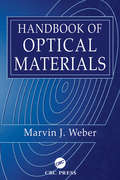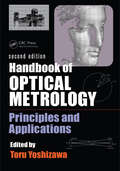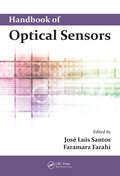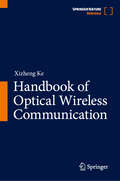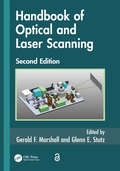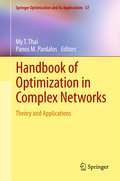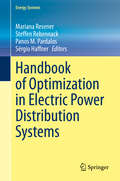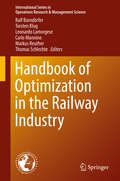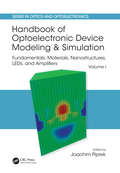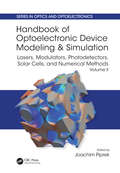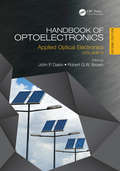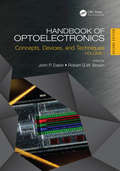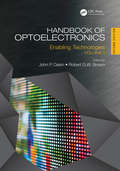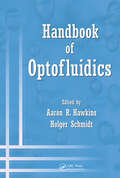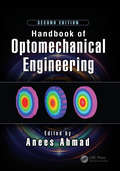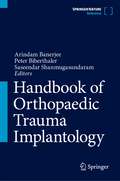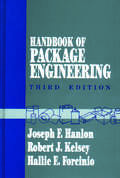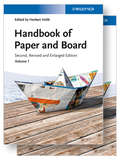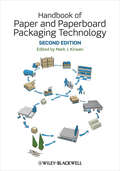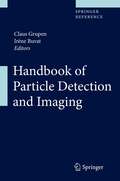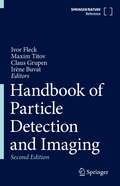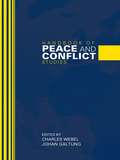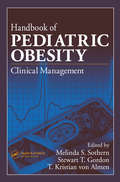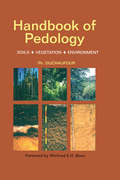- Table View
- List View
Handbook of Optical Materials: Optical Materials (Laser & Optical Science & Technology #19)
by Marvin J. WeberFor years scientists turned to the CRC Handbook of Laser Science & Technology for reliable data on optical materials. Out of print for several years, that standard-setting work now has a successor: the Handbook of Optical Materials.This new handbook is an authoritative compilation of the physical properties of materials used in all types of lasers and optical systems. In it, scientist, author, and editor Dr. Marvin J. Weber provides extensive data tabulations and references for the most important optical materials, including crystals, glasses, polymers, metals, liquids, and gases. The properties detailed include both linear and nonlinear optical properties, mechanical properties, thermal properties together with many additional special properties, such as electro-, magneto-, and elasto-optic properties. Using a minimum of narration and logically organized by material properties, the handbook's unique presentation simplifies the process of comparing different materials for their suitability in particular applications. Appendices furnish a wealth of other useful information, including lists of the many abbreviations and acronyms that proliferate in this field. The Handbook of Optical Materials is simply the most complete one-stop source available for materials data essential to lasers and optical systems.
Handbook of Optical Metrology: Principles and Applications, Second Edition
by Toru YoshizawaHandbook of Optical Metrology: Principles and Applications begins by discussing key principles and techniques before exploring practical applications of optical metrology. Designed to provide beginners with an introduction to optical metrology without sacrificing academic rigor, this comprehensive text: Covers fundamentals of light sources, lenses, prisms, and mirrors, as well as optoelectronic sensors, optical devices, and optomechanical elements Addresses interferometry, holography, and speckle methods and applications Explains Moiré metrology and the optical heterodyne measurement method Delves into the specifics of diffraction, scattering, polarization, and near-field optics Considers applications for measuring length and size, displacement, straightness and parallelism, flatness, and three-dimensional shapes This new Second Edition is fully revised to reflect the latest developments. It also includes four new chapters—nearly 100 pages—on optical coherence tomography for industrial applications, interference microscopy for surface structure analysis, noncontact dimensional and profile metrology by video measurement, and optical metrology in manufacturing technology.
Handbook of Optical Sensors
by José Luís Santos Faramarz FarahiHandbook of Optical Sensors provides a comprehensive and integrated view of optical sensors, addressing the fundamentals, structures, technologies, applications, and future perspectives. Featuring chapters authored by recognized experts and major contributors to the field, this essential reference: Explains the basic aspects of optical sensors and
Handbook of Optical Wireless Communication
by Xizheng KeThe book focuses on optical wireless communication systems. It summarises the author's work on optical wireless communication during the implementation of relevant scientific research plans. The main contents include the research status and progress of optical wireless communication, including the author's own work in this field and the research progress of domestic and foreign scholars in related fields. The key technologies, key components, modulation and coding methods, influencing factors of coherent optical communication, underwater optical communication, visible light communication, and orbital angular momentum involved in wireless optical communication are analysed, and their research progress and development trends are presented. It is particularly suitable for readers interested in the field of wireless optical communications. This book can benefit researchers, engineers and graduate students in the field of telecommunications. Suitable for engineering and technical personnel involved in optical communications, university teachers, postgraduate students and advanced undergraduates.
Handbook of Optical and Laser Scanning (Optical Science and Engineering)
by Gerald F. Marshall Glenn E. StutzFrom its initial publication titled Laser Beam Scanning in 1985 to Handbook of Optical and Laser Scanning, now in its second edition, this reference has kept professionals and students at the forefront of optical scanning technology. Carefully and meticulously updated in each iteration, the book continues to be the most comprehensive scanning resource on the market. It examines the breadth and depth of subtopics in the field from a variety of perspectives. The Second Edition covers: Technologies such as piezoelectric devices Applications of laser scanning such as Ladar (laser radar) Underwater scanning and laser scanning in CTP As laser costs come down, and power and availability increase, the potential applications for laser scanning continue to increase. Bringing together the knowledge and experience of 26 authors from England, Japan and the United States, the book provides an excellent resource for understanding the principles of laser scanning. It illustrates the significance of scanning in society today and would help the user get started in developing system concepts using scanning. It can be used as an introduction to the field and as a reference for persons involved in any aspect of optical and laser beam scanning.
Handbook of Optimization in Complex Networks
by Panos M. Pardalos My T. ThaiComplex Social Networks is a newly emerging (hot) topic with applications in a variety of domains, such as communication networks, engineering networks, social networks, and biological networks. In the last decade, there has been an explosive growth of research on complex real-world networks, a theme that is becoming pervasive in many disciplines, ranging from mathematics and computer science to the social and biological sciences. Optimization of complex communication networks requires a deep understanding of the interplay between the dynamics of the physical network and the information dynamics within the network. Although there are a few books addressing social networks or complex networks, none of them has specially focused on the optimization perspective of studying these networks. This book provides the basic theory of complex networks with several new mathematical approaches and optimization techniques to design and analyze dynamic complex networks. A wide range of applications and optimization problems derived from research areas such as cellular and molecular chemistry, operations research, brain physiology, epidemiology, and ecology.
Handbook of Optimization in Electric Power Distribution Systems (Energy Systems)
by Panos M. Pardalos Steffen Rebennack Mariana Resener Sérgio HaffnerThis handbook gathers state-of-the-art research on optimization problems in power distribution systems, covering classical problems as well as the challenges introduced by distributed power generation and smart grid resources. It also presents recent models, solution techniques and computational tools to solve planning problems for power distribution systems and explains how to apply them in distributed and variable energy generation resources. As such, the book therefore is a valuable tool to leverage the expansion and operation planning of electricity distribution networks.
Handbook of Optimization in the Railway Industry (International Series in Operations Research & Management Science #268)
by Ralf Borndörfer Torsten Klug Leonardo Lamorgese Carlo Mannino Markus Reuther Thomas SchlechteThis book promotes the use of mathematical optimization and operations research methods in rail transportation. The editors assembled thirteen contributions from leading scholars to present a unified voice, standardize terminology, and assess the state-of-the-art.There are three main clusters of articles, corresponding to the classical stages of the planning process: strategic, tactical, and operational. These three clusters are further subdivided into five parts which correspond to the main phases of the railway network planning process: network assessment, capacity planning, timetabling, resource planning, and operational planning. Individual chapters cover:SimulationCapacity AssessmentNetwork DesignTrain RoutingRobust TimetablingEvent SchedulingTrack AllocationBlockingShuntingRolling StockCrew SchedulingDispatching Delay Propagation
Handbook of Optoelectronic Device Modeling and Simulation: Fundamentals, Materials, Nanostructures, LEDs, and Amplifiers, Vol. 1 (Series in Optics and Optoelectronics)
by Joachim PiprekOptoelectronic devices are now ubiquitous in our daily lives, from light emitting diodes (LEDs) in many household appliances to solar cells for energy. This handbook shows how we can probe the underlying and highly complex physical processes using modern mathematical models and numerical simulation for optoelectronic device design, analysis, and performance optimization. It reflects the wide availability of powerful computers and advanced commercial software, which have opened the door for non-specialists to perform sophisticated modeling and simulation tasks. The chapters comprise the know-how of more than a hundred experts from all over the world. The handbook is an ideal starting point for beginners but also gives experienced researchers the opportunity to renew and broaden their knowledge in this expanding field.
Handbook of Optoelectronic Device Modeling and Simulation: Lasers, Modulators, Photodetectors, Solar Cells, and Numerical Methods, Vol. 2 (Series in Optics and Optoelectronics)
by Joachim PiprekOptoelectronic devices are now ubiquitous in our daily lives, from light emitting diodes (LEDs) in many household appliances to solar cells for energy. This handbook shows how we can probe the underlying and highly complex physical processes using modern mathematical models and numerical simulation for optoelectronic device design, analysis, and performance optimization. It reflects the wide availability of powerful computers and advanced commercial software, which have opened the door for non-specialists to perform sophisticated modeling and simulation tasks. The chapters comprise the know-how of more than a hundred experts from all over the world. The handbook is an ideal starting point for beginners but also gives experienced researchers the opportunity to renew and broaden their knowledge in this expanding field.
Handbook of Optoelectronics: Applied Optical Electronics (Volume Three) (Series in Optics and Optoelectronics)
by John P. Dakin Robert G. BrownHandbook of Optoelectronics offers a self-contained reference from the basic science and light sources to devices and modern applications across the entire spectrum of disciplines utilizing optoelectronic technologies. This second edition gives a complete update of the original work with a focus on systems and applications.Volume I covers the details of optoelectronic devices and techniques including semiconductor lasers, optical detectors and receivers, optical fiber devices, modulators, amplifiers, integrated optics, LEDs, and engineered optical materials with brand new chapters on silicon photonics, nanophotonics, and graphene optoelectronics. Volume II addresses the underlying system technologies enabling state-of-the-art communications, imaging, displays, sensing, data processing, energy conversion, and actuation. Volume III is brand new to this edition, focusing on applications in infrastructure, transport, security, surveillance, environmental monitoring, military, industrial, oil and gas, energy generation and distribution, medicine, and free space. No other resource in the field comes close to its breadth and depth, with contributions from leading industrial and academic institutions around the world. Whether used as a reference, research tool, or broad-based introduction to the field, the Handbook offers everything you need to get started. John P. Dakin, PhD, is professor (emeritus) at the Optoelectronics Research Centre, University of Southampton, UK. Robert G. W. Brown, PhD, is chief executive officer of the American Institute of Physics and an adjunct full professor in the Beckman Laser Institute and Medical Clinic at the University of California, Irvine.
Handbook of Optoelectronics: Concepts, Devices, and Techniques (Volume One) (Series in Optics and Optoelectronics)
by Robert Brown John P. DakinHandbook of Optoelectronics offers a self-contained reference from the basic science and light sources to devices and modern applications across the entire spectrum of disciplines utilizing optoelectronic technologies. This second edition gives a complete update of the original work with a focus on systems and applications.Volume I covers the details of optoelectronic devices and techniques including semiconductor lasers, optical detectors and receivers, optical fiber devices, modulators, amplifiers, integrated optics, LEDs, and engineered optical materials with brand new chapters on silicon photonics, nanophotonics, and graphene optoelectronics. Volume II addresses the underlying system technologies enabling state-of-the-art communications, imaging, displays, sensing, data processing, energy conversion, and actuation. Volume III is brand new to this edition, focusing on applications in infrastructure, transport, security, surveillance, environmental monitoring, military, industrial, oil and gas, energy generation and distribution, medicine, and free space. No other resource in the field comes close to its breadth and depth, with contributions from leading industrial and academic institutions around the world. Whether used as a reference, research tool, or broad-based introduction to the field, the Handbook offers everything you need to get started. (The previous edition of this title was published as Handbook of Optoelectronics, 9780750306461.) John P. Dakin, PhD, is professor (emeritus) at the Optoelectronics Research Centre, University of Southampton, UK. Robert G. W. Brown, PhD, is chief executive officer of the American Institute of Physics and an adjunct full professor in the Beckman Laser Institute and Medical Clinic at the University of California, Irvine.
Handbook of Optoelectronics: Enabling Technologies (Volume Two) (Series in Optics and Optoelectronics)
by John P. Dakin Robert G. BrownHandbook of Optoelectronics offers a self-contained reference from the basic science and light sources to devices and modern applications across the entire spectrum of disciplines utilizing optoelectronic technologies. This second edition gives a complete update of the original work with a focus on systems and applications.Volume I covers the details of optoelectronic devices and techniques including semiconductor lasers, optical detectors and receivers, optical fiber devices, modulators, amplifiers, integrated optics, LEDs, and engineered optical materials with brand new chapters on silicon photonics, nanophotonics, and graphene optoelectronics. Volume II addresses the underlying system technologies enabling state-of-the-art communications, imaging, displays, sensing, data processing, energy conversion, and actuation. Volume III is brand new to this edition, focusing on applications in infrastructure, transport, security, surveillance, environmental monitoring, military, industrial, oil and gas, energy generation and distribution, medicine, and free space. No other resource in the field comes close to its breadth and depth, with contributions from leading industrial and academic institutions around the world. Whether used as a reference, research tool, or broad-based introduction to the field, the Handbook offers everything you need to get started. (The previous edition of this title was published as Handbook of Optoelectronics, 9780750306461.) John P. Dakin, PhD, is professor (emeritus) at the Optoelectronics Research Centre, University of Southampton, UK. Robert G. W. Brown, PhD, is chief executive officer of the American Institute of Physics and an adjunct full professor in the Beckman Laser Institute and Medical Clinic at the University of California, Irvine.
Handbook of Optofluidics
by Holger Schmidt Haron R. HawkinsOptofluidics is an emerging field that involves the use of fluids to modify optical properties and the use of optical devices to detect flowing media. Ultimately, its value is highly dependent on the successful integration of photonic integrated circuits with microfluidic or nanofluidic systems. Handbook of Optofluidics provides a snapshot of the s
Handbook of Optomechanical Engineering (Optical Sciences and Applications of Light)
by Anees AhmadThis comprehensive handbook covers all major aspects of optomechanical engineering - from conceptual design to fabrication and integration of complex optical systems. The practical information within is ideal for optical and optomechanical engineers and scientists involved in the design, development and integration of modern optical systems for commercial, space, and military applications. Charts, tables, figures, and photos augment this already impressive text. Fully revised, the new edition includes 4 new chapters: Plastic optics, Optomechanical tolerancing and error budgets, Analysis and design of flexures, and Optomechanical constraint equations.
Handbook of Orthopaedic Trauma Implantology
by Arindam Banerjee Peter Biberthaler Saseendar ShanmugasundaramThis reference work comprehensively covers essential orthopedic trauma implants and their application in both upper and lower limbs. It offers insights into the invention, advantages, and disadvantages of various implants, along with the rationale behind their current designs, biomechanics, and materials. Additionally, the book addresses fracture fixation and general considerations when comparing different subgroups of implants, such as nails versus plates or ORIF versus external fixation.The book is divided into several sections, such as upper and lower limbs, spine, and pelvis. It also includes unique sections dedicated to pediatric implants, implant removal, metallurgy and bone grafts. It is written and edited by experienced surgeons from around the world. This book fills the gap as currently, there are no specific reference books on this topic but only operative manuals and inventory lists of various commercial companies detailing their own products.This highly informative and meticulously presented book serves as both a practical and a theoretical guide for practicing orthopedic surgeons, scientists/researchers, academicians, students as well as orthopedic technicians and nurses.
Handbook of Oxidative Stress in Cancer: Mechanistic Aspects
by Sajal Chakraborti Bimal K. Ray Susanta RoychoudhuryThis comprehensive, up-to-date reference work compiles the scientific research on the relationship between various forms of cancer and reactive oxygen species (ROS). It is well known that ROS play a key role in the various steps leading to malignancy, this includes increase in DNA mutation rates. The book brings together exciting reviews, written by leading experts all over the world. The book is divided into four broad sections. Each section describes the role of oxidative stress and underlying mechanisms and pathways, at various stages of cancer, including its role in carcinogenesis, cancer progression and metastasis. Further, the book describes how the reactive oxygen species (ROS) modulate gene expression and signal transduction pathways in cancer. The book discusses the ways to interfere with the cancer progression, and design of anti-cancer drugs. The book provides an integrated approach for better understanding of the development phases of oxidative stress-induced cancers, and mainly the current perspectives about mechanistic aspects of cancer initiation, progression and metastasis. It is a highly resourceful book and would be extremely important to clinicians, students and researchers in the field of cancer genetics, therapeutics and oncology.
Handbook of Package Engineering
by Joseph F. Hanlon Robert J. KelseyNow in its third edition, the Handbook of Package Engineering is still considered the standard industry reference on packaging materials and engineering. This text is a useful source of information for anyone involved in packaging. Designed as a refresher on packaging fundamentals, this complete guide also provides information on recent changes in
Handbook of Paper and Board
by Herbert HolikPapermaking is a fascinating art and technology. The second edition of this successful handbook provides a comprehensive view on the technical, economic, ecologic and social background of paper and board. It has been updated, revised and largely extended in depth and width including the further use of paper and board in converting and printing. A wide knowledge basis is a prerequisite in evaluating and optimizing the whole process chain to ensure efficient paper and board production. The same is true in their application and end use.The 2 Volume Set covers a wide range of topics:Raw materials required for paper and board manufacturing such as fibers, chemical additives and fillersProcesses and machinery applied to prepare the stock and to produce the various paper and board grades including automation and trouble shootingPaper converting and printing processes, book preservationThe different paper and board grades as well as testing and analysing fiber suspensions, paper and board products, and converted or printed mattersEnvironmental and energy factors as well as safety aspectsThe handbook provides professionals in the field, e. g. papermakers as well as converters and printers, laymen, students, politicians and other interested people with the most up-to-date and comprehensive information on the state-of- the-art techniques and aspects involved in paper making, converting and printing.From the reviews of the previous edition:"...excellent and easily accessible to the non-engineer and... the general reader." -CHOICE"...a one-of-a-kind text on paper production-a selection observed for its crisp and sharp efficiency." -Electric Review
Handbook of Paper and Paperboard Packaging Technology
by Mark J. KirwanThe definitive industry reference on the paper and paperboard packaging sector. Now in a fully revised and updated second edition, this book discusses all the main types of packaging based on paper and paperboard. It considers the raw materials, the manufacture of paper and paperboard, and the basic properties and features on which packaging made from these materials depends for its appearance and performance. The manufacture of twelve types of paper- and paperboard-based packaging is described, together with their end-use applications and the packaging machinery involved. The importance of pack design is stressed, as well as how these materials offer packaging designers opportunities for imaginative and innovative design solutions. Environmental factors, including resource sustainability, societal and waste management issues are addressed in a dedicated chapter. The book is directed at readers based in companies which manufacture packaging grades of paper and paperboard, companies involved in the design, printing and production of packaging, and companies which manufacture inks, coatings, adhesives and packaging machinery. It will be essential reading for students of packaging technology and technologists working in food manufacturing who are users of paper and paperboard packaging products. Praise for the First Edition ‘This book is a valuable addition to the library of any forward-looking company by providing in-depth coverage of all aspects of packaging which involve the most ecologically acceptable material, namely paper and paperboard.’—International Journal of Dairy Technology ‘...a welcome contribution to a field where coverage was previously limited to subject-specific books... or to single chapters in textbooks on broader aspects of packaging technology.’—Packaging Technology and Science
Handbook of Particle Detection and Imaging
by Claus Grupen Irène BuvatThe handbook centers on detection techniques in the field of particle physics, medical imaging and related subjects. It is structured into three parts. The first one is dealing with basic ideas of particle detectors, followed by applications of these devices in high energy physics and other fields. In the last part the large field of medical imaging using similar detection techniques is described. The different chapters of the book are written by world experts in their field. Clear instructions on the detection techniques and principles in terms of relevant operation parameters for scientists and graduate students are given.Detailed tables and diagrams will make this a very useful handbook for the application of these techniques in many different fields like physics, medicine, biology and other areas of natural science.
Handbook of Particle Detection and Imaging
by Claus Grupen Irène Buvat Ivor Fleck Maxim TitovThis handbook covers the fundamental principles of interactions of particles with matter and of most types of detectors used in many fields of physics, starting from particle physics, nuclear physics up to recent experiments for solid state physics. In this second edition chapters are updated to include the most recent developments in detector physics and additional chapters on new types of detectors, like silicon photomultipliers, have been added. In addition the section about medical applications has been extended. All major detector types are described in detail by leading experts in these fields. It also gives deep insight into many applications from homeland security over radiation protection to a whole section about medical physics with strong emphasis on nuclear medicine. The book is suited to achieve a deep knowledge in the field of detector physics and imaging. It can also be used as a reference book to look up the working principles of a given detector type and to get an overview of state-of-the-art applications of the various detector types. It is also helpful for practitioners in nuclear medicine and radiology as it summarizes all detector types in this field and the basic working principles of these detectors. The area of radiation therapy is also covered in detail taking into account the most recent developments.
Handbook of Peace and Conflict Studies (Weber in Translation)
by Johan Galtung Charles WebelThis major new Handbook provides a cutting-edge and transdisciplinary overview of the main issues, debates, state-of-the-art methods, and key concepts in peace and conflict studies today. The fields of peace and conflict studies have grown exponentially since being initiated by Professor Johan Galtung half a century ago. They have forged a transdisciplinary and professional identity distinct from security studies, political science, and international relations. The volume is divided into four sections: understanding and transforming conflict creating peace supporting peace peace across the disciplines. Each section features new essays by distinguished international scholars and professionals working in peace studies and conflict resolution and transformation. Drawing from a wide range of theoretical, methodological, and political positions, the editors and contributors offer topical and enduring approaches to peace and conflict studies. The Handbook of Peace and Conflict Studies will be essential reading for students of peace studies, conflict studies and conflict resolution. It will also be of interest and use to practitioners in conflict resolution and NGOs, as well as policy makers and diplomats.
Handbook of Pediatric Obesity: Clinical Management
by Melinda S. Sothern Stewart T. Gordon T. Kristian von AlmenA compilation of management, medical, nutrition, psychological, and physical activity facts, models, theories, interventions, and evaluation techniques, the Handbook of Pediatric Obesity: Clinical Management is the most clinically appropriate and scientifically supported source of information available for pediatric health care and research profess
Handbook of Pedology
by Ph. DuchaufourBased on the new World Reference Base for Soil Resources, this text shows the reciprocity between the soil, its environment and vegetation. Updated with the most recent results in the area, it presents a wide spectrum of practical applications, in land improvement, plant growth and the environment.
